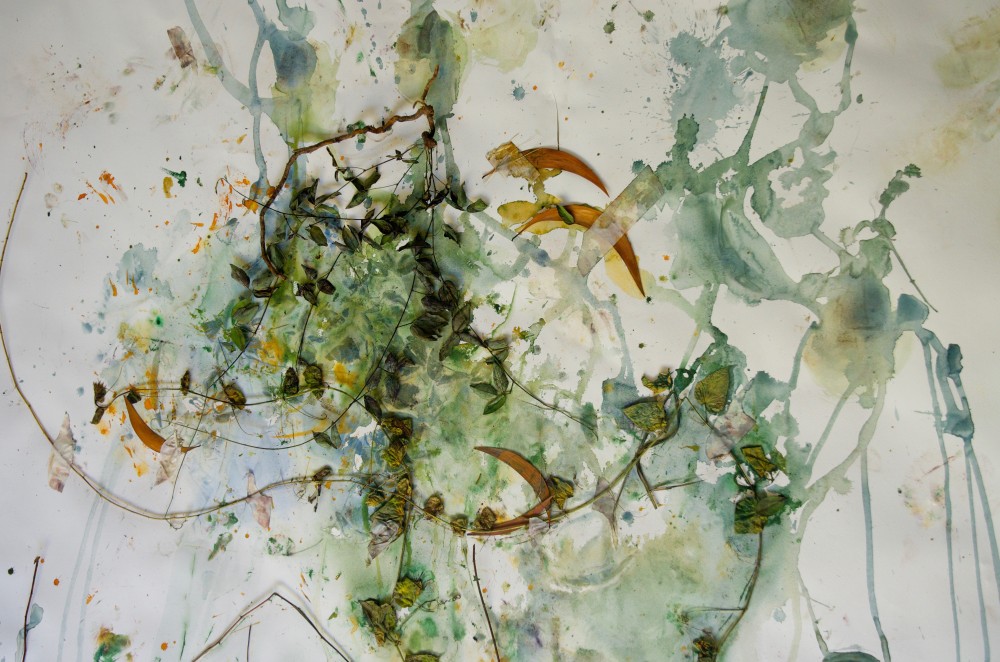Exhibitions John Wolseley with Mulkun Wirrpanda - Marrma Dilakmala Larruma Gurra Ŋathawu - Two Old Artists Looking for Food
29.10.15 to 21.11.15
John Wolseley with Mulkun Wirrpanda
Marrma dilakmala larruma gurra ŋathawu
Two old artists looking for food

Roslyn Oxley9 Gallery, Sydney
29 October - 21 November, 2015
John Wolseley and Mulkun Wirrpanda first met in 2009. Mulkun is a great Yolŋu artist and ceremonial leader of the Dhudi-djapu clan of East Arnhem Land.
John was in Baniyala as one of the group of Yolŋu and balanda artists working on the project which resulted in the wonderful touring exhibition Djalkiri – We are standing on the their names - organised by Nomad Art of Darwin. Over several weeks the artists and visiting scientists and anthropologists were hosted by Djambawa Marawili. They drew and worked on their etchings and lithographs around Blue Mud Bay and later in the Buku-Larrnggay Mulka Centre in Yirrkala. After a day spent harvesting tubers and yams, Mulkun asked John to be her wawa or brother and gave him the name of Langgurrk, a type of beetle grub which lives in mud and yams. Since then they have met each year in the Midawarr season, wandering through rainforest and floodplain, and gathering and painting the rich diversity of yam, tuber and fruit.
Mulkun had already started to paint the epic series of bark paintings and larrakitj about the plants of her homeland a small section of which is included in this exhibition. This powerful group of paintings demonstrates her urgent and passionate desire to pass on to new generations her vast knowledge before it is lost.
It is the intense focus on the particular and unique plants and trees of this wild and powerful country which links these works. Both artists depict the character and energy of a vine like Flagellaria indica as it climbs into the canopy - hooking on to the branches with long prehensile leaves in the way monkeys do with their tails. Similarly, one of the many tropical plants with yams and tubers such as Cayratia maritima is painted by each artist in its three forms or sub-species; one which lives by the Garrangari flood plain, and another on a small island out to sea.
The artists have also collaborated in a series of woodcuts on Huon pine – The Midawarr harvest series. Seven large prints by Mulkun and five by John celebrate the same edible plants. These were made and printed at the Buku-Larrnggay print workshop and John’s studio in the Whipstick forest near Bendigo.
During this time John, taking on the viewpoint of the Langgurrk, made a number of prints directly from the ‘life histories’ engraved by beetle species, under the bark of trees. The ‘ Boring Moth and Beetle Compendium’ 2015 is a group of relief prints showing the progression of changes undergone by a beetle during its lifetime. In a fallen branch randomly chosen from the forest floor, he has found a whole world in miniature form. An epic story of birth and transformation which brings to mind the connection the ancient Egyptians saw between the scarab beetles rolling a ball of dung across the ground and the way the sun rolls across the sky and is reborn each dawn.
In the layout of this exhibition the artists have juxtaposed their very different paintings and woodcuts of the same plants and trees. Here the same mawuka yam or darwirr vine are viewed through the lens of two completely different world views and two completely different ways of representation. Wirrpanda’s art flows from a culture which has evolved over thousands of years out of the country itself. Wolseley’s art is part of the European landscape tradition based on the study of the physical and natural world through observation and experience.
Though coming from such different directions, there are correspondences and synchronies between these works. In a curious way, aspects of the scientific foundation of the European tradition correspond to elements in Wirrpanda’s Yolŋu approach. Her depiction of plants and their habitats reveal her huge knowledge of seasonal changes, morphologies and types of energy. Howard Morphy has recognized the complexity of this knowledge system; pointing to the Yolŋu ….’belief that the surface forms of things derive from underlying structures and relationships’.[i]
What also connects these artists is a strong belief in the originary and primary importance of the natural world – its plants, animals and eco-systems. And a shared awareness of how our accelerating loss of connection with country will result in damage beyond repair.
‘The task of the artist is to keep and repair the sacred web of creation’ – George Mackay Brown
[i] Howard Morphy, Becoming Art: Eploring Cross-cultural Categories, Bloomsbury, London, 2008.
Ganguri, Yirriŋaŋiŋ, Dhunguruk, Dirridirri 2015
watercolour, graphite, plant leaf on paper
75 x 201cm









